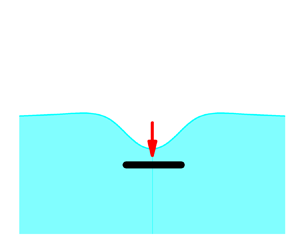Article contents
Impulsive impact of a submerged body
Published online by Cambridge University Press: 25 May 2021
Abstract

An analytical solution of the impulsive impact of a cylindrical body submerged below a calm water surface is obtained by solving a free boundary problem. The shape of the cross-section of the body is arbitrary. The integral hodograph method is applied to derive the complex velocity potential defined in a parameter plane. The boundary-value problem is reduced to a Fredholm integral equation of the first kind in the velocity magnitude on the free surface. The velocity field, the impulsive pressure on the body surface and the added mass are determined in a wide range of depths of submergence for various cross-sectional shapes, such as a flat plate, a circular cylinder and a rectangle.
- Type
- JFM Rapids
- Information
- Copyright
- © The Author(s), 2021. Published by Cambridge University Press
References
REFERENCES
- 4
- Cited by



